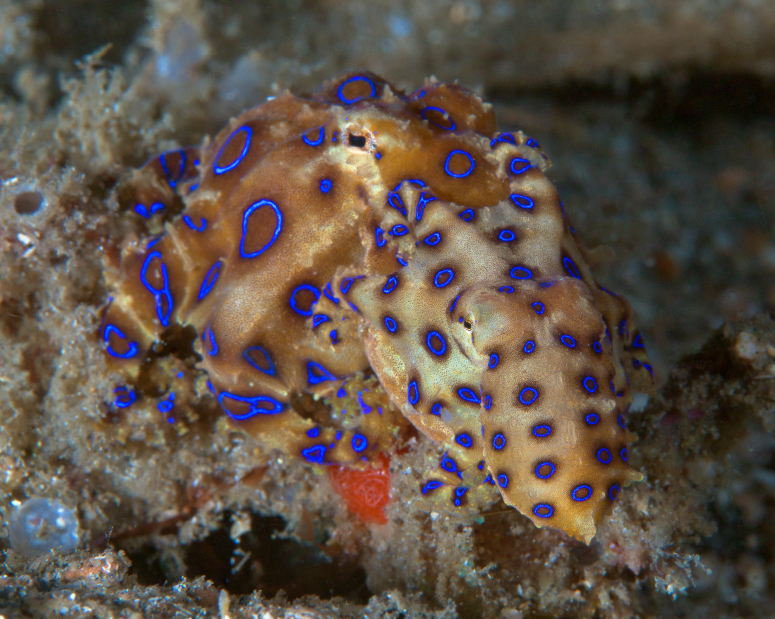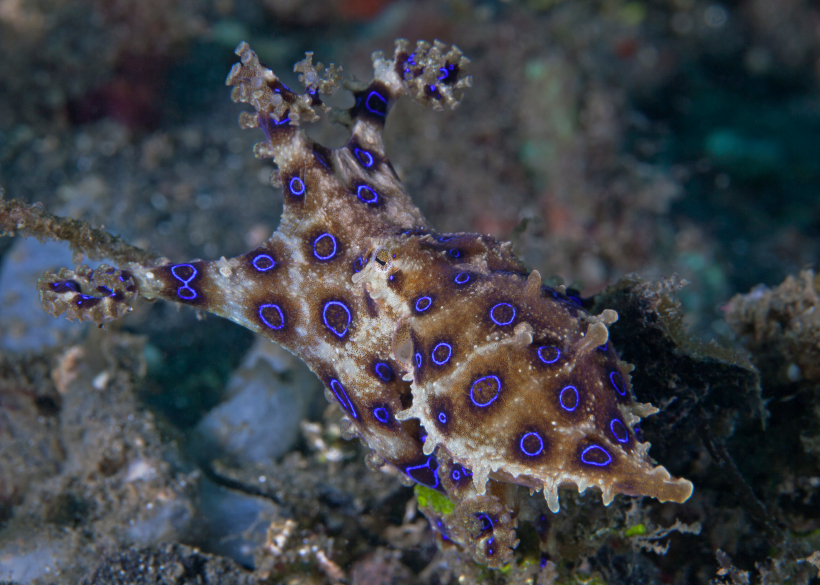While the genus Hapalochlaena contains between five and 10 species, Hapalochlaena maculosa, the southern blue-ringed octopus, and Hapalochlaena lunulata, the greater blue-ringed octopus, are the two divers most commonly see. Greater blue-ringed octopus live in the coastal waters of Australia, New Guinea, Indonesia, the Philippines, Malaysia, Japan, the Solomon Islands and Sri Lanka to a depth of 66 feet (20 meters). Southern blue-ringed octopuses prefer southern Australia, southwestern Australia and eastern Victoria, where they live in water as deep as 165 feet (50 meters). Adult blue-ringed octopuses grow to a span of 5 to 8 inches and weigh less than one ounce. Of the two species, the greater blue-ringed octopus is the larger.
What makes the rings blue?
Their striking colors, in the form of 50 to 60 bright blue, pulsating rings, only appear when the animals become agitated. When they’re resting, their coloration is muted. The lesser blue-ringed octopuses are grey and beige with brown patches, while the greater blue-ringed octopuses are dark brown and grey. Like most species that employ flamboyant coloration as a warning to potential predators, the blue-ringed octopus is highly venomous, one of the most venomous animals in the world. Because of their diminutive size, these octopuses don’t stand a chance against larger predators without the aid of an impressive arsenal, which comes in the form of a symbiotic relationship with bacteria living in their salivary glands, filled with toxins.
How deadly is the blue-ringed octopus?
The salivary gland used most commonly by the octopuses is harmless to humans. The toxin in this gland anesthetizes crabs and other prey. The second salivary gland, meant for protection, is full of tetrodotoxin. Pufferfish and cone snails also have this tetrodoxin. It’s 10,000 times more deadly than cyanide, taking only 1mg to kill a man. The toxin works by blocking the sodium channels in nerve cells. This prevents sodium ions from entering the cells and disrupts nerve conduction. When nerve impulses cease, the body becomes paralyzed. During this paralysis, the victim’s pupils will dilate and fix. Before succumbing to hypoxia, the victim — despite their unresponsive state — will know what is occurring.
So successful is this toxin that one envenomation by a blue-ringed octopus can kill 26 adult humans. A blue-ringed octopus bite is painless and divers won’t usually notice it. The symptoms appear immediately, however, and follow a predictable path. The victim first begins to feel nauseous. Then their vision blurs, followed by complete loss of sight. Next they lose the sense of touch, followed by an inability to speak and swallow. Paralysis quickly occurs. Envenomation to a complete shutdown of the respiratory system — the official cause of death — takes only three minutes without immediate medical intervention.
There is no anti-venom for tetrodotoxin. The victim’s body must metabolize it, which takes roughly 24 hours. During this time, the victim must receive continuous CPR. If you know where the bite is, apply a pressure-immobilization bandage to help prevent the toxin’s spread. Once the tetrodotoxin is out of the victim’s system, there should be no long-term effects with the proper treatment.
Blue-ringed octopus are not aggressive
While knowing that we’re swimming in the same waters as such a deadly creature can be unsettling, negative encounters with blue-ringed octopuses are rare. These animals prefer to avoid conflict and human interaction. All reported bites are due to divers provoking the octopus, either purposely or by accidentally stepping on one. For those daring photographers who want to brave a close encounter with these blue-speckled beauties, keep in mind that the beaks of these animals can penetrate a wetsuit. If you see a blue-ringed octopus, observe it from afar. Should the animal become agitated, leave the area immediately. As beautiful as these animals are when they are fully illuminated, don’t risk your life or cause the animal stress because of your presence.



